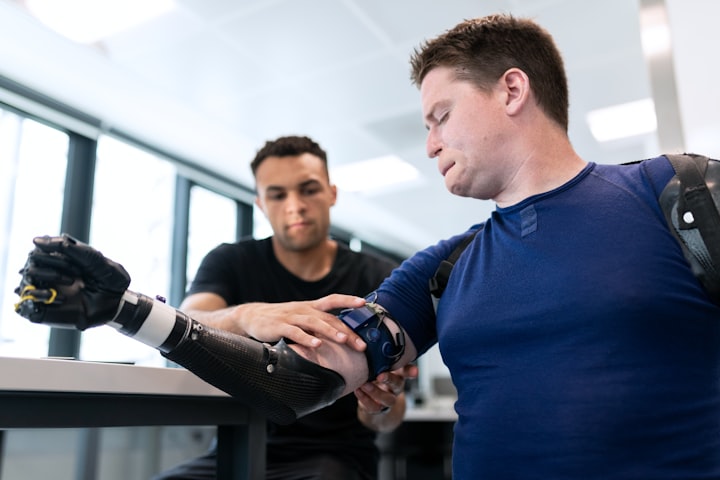Enhancing Lives with Prosthetics: How These Devices Are Improving Quality of Life
"The Incredible Stories of People Whose Lives Have Been Changed by Prosthetics"

History of Prosthetics
As mentioned, prosthetics have been around since ancient times, with evidence of artificial toes and fingers found in Egyptian tombs dating back to 950 BC. The Romans also made prosthetics, including metal arms and legs, which were often used by gladiators who had lost limbs in battle.
During the Middle Ages, prosthetics continued to evolve, with wooden limbs becoming more common. These devices were often crude and uncomfortable, and patients had to endure a great deal of pain and discomfort to wear them.
The introduction of anesthesia in the mid-19th century revolutionized the field of prosthetics, as it made it possible for patients to undergo more complex surgical procedures. With the development of new materials, such as rubber and plastics, prosthetics became more comfortable and durable.
Types of Prosthetics
There are several types of prosthetics available today, each designed to replace a specific missing body part. Here is a closer look at each type:
Upper Limb Prosthetics: These prosthetics are designed to replace missing arms, hands, and fingers. There are two main types of upper limb prosthetics: body-powered prosthetics and myoelectric prosthetics. Body-powered prosthetics use a harness or cable system to control movement, while myoelectric prosthetics use sensors to detect electrical signals produced by the patient's muscles, allowing them to control the movement of their prosthetic limb.
Lower Limb Prosthetics are designed to replace missing legs, feet, and toes. Like upper limb prosthetics, there are two main types of lower limb prosthetics: passive prosthetics and active prosthetics. Passive prosthetics are designed to provide support and stability, while active prosthetics use microprocessors to control movement and provide a more natural gait.
Facial Prosthetics: These prosthetics are designed to replace missing or damaged facial features, such as noses, ears, and eyes. They are typically made from silicone and are custom-fit to the patient's unique facial structure. Facial prosthetics are often used to treat conditions such as cancer or traumatic injuries.
Advances in Prosthetics
The field of prosthetics has seen incredible advances in recent years, thanks to advances in technology and materials. Here are some of the most exciting advances in prosthetics:
Bionic Prosthetics: Bionic prosthetics are devices that are controlled by the patient's thoughts, using myoelectric sensors. These sensors detect the electrical signals produced by the patient's muscles, allowing them to control the movement of their prosthetic limb. Bionic prosthetics have revolutionized the field of prosthetics, giving patients a greater range of motion and a more natural feel.
3D printing technology has made it possible to create custom-fit prosthetics quickly and affordably. Using a 3D printer, prosthetics can be designed and manufactured in a matter of hours, reducing the time and cost of production. This technology has also made it possible to create prosthetics with complex geometries, which would be difficult or impossible to create using traditional manufacturing methods.
Osseointegration: Osseointegration is a surgical procedure that involves implanting a titanium rod into the patient's bone, which then fuses with the bone over time. This creates a strong and stable connection between the prosthetic device and the patient's body, allowing for greater mobility and functionality. Osseointegration is most commonly used for lower limb prosthetics, where it has been shown to improve patients' quality of life and reduce the risk of prosthetic-related complications.
Conclusion
Prosthetics have come a long way since their inception, and today they offer incredible opportunities for people with missing or damaged limbs to regain their independence and improve their quality of life. With advances in technology and materials, prosthetics are becoming more advanced, more natural-looking, and more affordable than ever before.
However, there are still many challenges in the field of prosthetics that need to be addressed. For example, prosthetics can be prohibitively expensive, and many insurance companies do not cover the cost of these devices. Additionally, not all prosthetics are suitable for all patients, and some people may experience discomfort or difficulty using them.
Research is ongoing in the field of prosthetics, and scientists and engineers are continually developing new technologies and materials to improve these devices. The ultimate goal is to create prosthetics that are indistinguishable from natural limbs, both in terms of appearance and functionality.
In conclusion, prosthetics have come a long way since their ancient origins, and today they offer incredible opportunities for people with missing or damaged limbs to regain their independence and improve their quality of life. With ongoing research and development, the field of prosthetics will undoubtedly continue to evolve, offering even more advanced and sophisticated devices in the years to come.

About the Creator
MAKING REAL MONEY
Follow me!






Comments
There are no comments for this story
Be the first to respond and start the conversation.